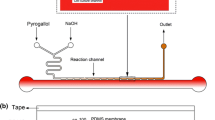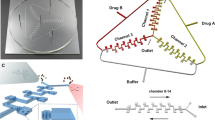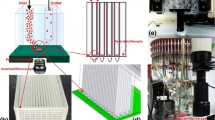Abstract
Micro total analysis systems (-TAS) or labs-on-a-chip, have been spreading rapidly due to their desirable characteristics, including reductions in reagent consumption, space requirements and analysis time. This work aimed at establishing an integrated microfluidic system which can supply the cells with fresh medium of oxygen and nutrition continuously at a control flow rate mimicking the microenvironment in vivo. Human non-small cell lung cancer cell line SPCA1 was seeded in a microchip supplied with fresh medium at a constant rate of 15 mm/24 h controlled by a pump. The expression of P-gp for verapamil-pretreated or non-pretreated cells was assayed with immunofluorescence. Both groups cells were exposed to anticancer drug VP-16 at 30 μM for 6 h before the apoptosis analysis online. The results indicated that the cells could grow and spread well for 4 days in the microfluidic system successively furnished with fresh medium. Immunofluorescence assay showed that the intensity of the fluorescence for the verapamil-pretreated cells was obvious weak compared with that of non-pretreated cells. Apoptosis analysis demonstrated that the percentage of apoptotic cells for verapamil-pretreated group increased around twofold compared with that of non-verapamil pretreated group (26.5 ± 2.5% versus 10.9 ± 0.85%, p < 0.05), showing a similar results as by flow cytometry analysis. All these indicate that P-gp plays an important role in the resistance to VP-16 in SPCA1, the microfluidic system provides a suitable environment for cells survival and is valuable in long time cell culture and bioassays mimicking the microenvironment in vivo and deserved to be studied further.








Similar content being viewed by others
References
H. Andersson, A. Van Den Berg, Sens. Actuators 92, 315–325 (2003)
X.F. Che, Y. Nakajima, T. Sumizawa, R. Ikeda, X.Q. Ren, C.L. Zheng, M. Mukai, T. Furukawa, M. Haraguchi, H. Gao, Y. Sugimoto, S. Akiyama, Cancer Lett. 187, 111–119 (2002)
S.H. Choi, S.E. Jin, M.K. Lee, S.J. Lim, J.S. Park, B.G. Kim, W.S. Ahn, C.K. Kim, Eur. J. Pharm. Biopharm. 68, 545–554 (2008)
S.K.W. Dertinger, D.T. Chiu, N.L. Jeon, G.M. Whitesides, Anal. Chem. 73, 1240–1246 (2001)
J. El-Ali, P.K. Sorger, K.F. Jensen, Nature 442, 403–411 (2006)
S.J. Froelich-Ammon, N. Osheroff, J. Biol. Chem. 270, 21429–21432 (1995)
C. Hrycyna, Cell Dev. Biol. 12, 247–256 (2001)
A. Khademhosseini, R. Langer, J. Borenstein, J.P. Vacanti, Proc. Natl. Acad. Sci. 103, 2480–2487 (2006)
V. Ponce de León, R. Barrera-Rodríguez, Cancer Cell Int. 5(1), 20 (2005)
D. Reyes, D. Iossifidis, P. Auroux, A. Manz, Anal. Chem. 74, 2623–2636 (2002)
Z.E. Sauna, M.M. Smith, M. Müller, K.M. Kerr, Ambudkar SV. J. Bioenerg. Biomembr. 33, 481–491 (2001)
A.W. Tilles, H. Baskaran, P. Roy, M.L. Yarmush, M. Toner, Biotechnol. Bioeng. 73, 379–389 (2001)
A. Tomida, T. Tsuruo, Anticancer Drug Des. 14, 169–177 (1999)
Y.S. Torisawa, A. Takagi, Y. Nashimoto, T. Yasukawa, H. Shiku, T. Matsue, Biomaterials 28, 559–566 (2007)
A. Tudos, G. Besselink, R. Schasfoort, Lab Chip 1, 83–95 (2001)
E. Verpoorte, Electrophoresis 23, 677–712 (2002)
Y. Wang, W. Wang, S. Wang, BMC Cancer 8, 372–381 (2008)
C.Q. Yi, C.W. Li, S.L. Ji, M.S. Yang, Anal. Chim. Acta 560, 1–23 (2006)
Acknowledgement
This work was supported by National Nature Science Foundation of China.
Author information
Authors and Affiliations
Corresponding author
Additional information
Zhao Long and Wang Zhenshan both contributed equally.
Rights and permissions
About this article
Cite this article
Zhao, L., Wang, Z., Fan, S. et al. Chemotherapy resistance research of lung cancer based on micro-fluidic chip system with flow medium. Biomed Microdevices 12, 325–332 (2010). https://doi.org/10.1007/s10544-009-9388-3
Published:
Issue Date:
DOI: https://doi.org/10.1007/s10544-009-9388-3




